Investigation of Plasma-Electrolytic Processing on EDMed Austenitic Steels
Abstract
1. Introduction
2. Materials and Methods
3. Results
3.1. The Results of the Microstructure of Samples Processed via Various Processing Routes
3.2. Results of the Elemental Composition of the Surface Layer of the Samples
3.3. The Results of Measuring the Roughness of the Machined Surface
3.4. Results of Measurement of Residual Stresses on the Surface of Samples
3.5. Fatigue Life Test Results
4. Conclusions
- It has been established that a defective white (recast) layer is formed during the EDM process. In the productive rough machining mode, the thickness of the white layer is 3.3 times greater than in the finishing machining mode. PeP technology can significantly reduce the white (recast) thickness. It is advocated that for the complete removal of the white layer from the EDMed surface in the rough machining mode, the PeP processing time should be extended.
- It is shown that the integrated EDM and subsequent PeP do not have a significant effect on the elemental composition of steel 12Cr18Ni10Ti. The elements deposition of the working fluid, electrolyte solution, and material from the electrode tool is not observed.
- It has been established that during the EDM in the rough machining mode, the roughness indicators are significantly worse than those of the sample obtained using the turning method. The arithmetic mean deviation of the Ra profile is 4.3 times higher on the EDMed surface. In the process of the PeP process, there is a significant decrease in all roughness parameters (Ra, Rz, Rmax). The Ra parameter decreased by 5.2 times. The Rz parameter decreased by 4.7 times. The maximum profile height Rmax decreased by 3.8 times.
- It is revealed that the maximum tensile residual stresses were obtained in the rough machining mode of the EDM. PeP technology reduces residual stresses by more than 2.5 times.
- It is demonstrated that the EDMed samples in the rough machining mode failed after 1.63 × 106 cycles when tested for gigacycle fatigue life. The samples obtained using the EDM method in the finishing mode failed after 4.69 × 106 cycles. The samples obtained using the turning method are not destroyed. The failure in the EDMed sample is due to the presence of a white (recast) layer on the samples. The treatment of these samples with the PeP process considerably increased their fatigue life. Most of the samples obtained by the methods of EDM in the finish machining mode and turning are not destroyed/failed.
- It is shown that EDM in rough mode and subsequent PeP makes it possible to obtain roughness and the mechanical properties proportional to the products obtained using the turning method. However, this combined technology requires additional research to stabilize the PeP process and to ensure consistent removal of the unwanted defective layers after the PeP process.
Author Contributions
Funding
Institutional Review Board Statement
Informed Consent Statement
Data Availability Statement
Conflicts of Interest
References
- Uthayakumar, M.; Prabhaharan, G.; Aravindan, S.; Sivaprasad, J.V. Machining studies on bimetallic pistons with CBN tool using the Taguchi method—Technical communication. Mach. Sci. Technol. 2008, 12, 249–255. [Google Scholar] [CrossRef]
- Uthayakumar, M.; Prabhakaran, G.; Aravindan, S.; Sivaprasad, J.V. Influence of Cutting Force on Bimetallic Piston Machining by a Cubic Boron Nitride (CBN) Tool. Mater. Manuf. Process. 2012, 27, 1078–1083. [Google Scholar] [CrossRef]
- Manikandan, G.; Uthayakumar, M.; Aravindan, S. Machining and simulation studies of bimetallic pistons. Int. J. Adv. Manuf. Technol. 2013, 66, 711–720. [Google Scholar] [CrossRef]
- Malakizadi, I.; Sadik, L. Nyborg, Wear Mechanism of CBN Inserts During Machining of Bimetal Aluminum-grey Cast Iron Engine Block. Procedia CIRP 2013, 8, 188–193. [Google Scholar] [CrossRef]
- Mahajan, A.; Sidhu, S.S. Enhancing biocompatibility of Co-Cr alloy implants via electrical discharge process. Mater. Technol. 2018, 33, 524–531. [Google Scholar] [CrossRef]
- Han, F.; Jiang, J.; Yu, D. Influence of discharge current on machined surfaces by thermo-analysis in finish cut of WEDM. Int. J. Mach. Tools Manuf. 2007, 47, 1187–1196. [Google Scholar] [CrossRef]
- Pour, G.T.; Pour, Y.T.; Ghoreishi, M. Thermal model of the electro-spark nanomachining process. Int. J. Mater. Mech. Manuf. 2014, 2, 56–59. [Google Scholar] [CrossRef]
- Świercz, R.; Holubek, R. Experimental investigation of influence electrical discharge energy on the surface layer properties after EDM. Weld. Technol. Rev. 2020, 92, 7–13. [Google Scholar] [CrossRef]
- Liu, J.; Guo, Y.; Butler, T.; Weaver, M. Crystallography, compositions, and properties of white layer by wire electrical discharge machining of nitinol shape memory alloy. Mater. Des. 2016, 109, 1–9. [Google Scholar] [CrossRef]
- Klocke, F.; Hensgen, L.; Klink, A.; Ehle, L.; Schwedt, A. Structure and composition of the white layer in the wire-EDM process. Procedia CIRP 2016, 42, 673–678. [Google Scholar] [CrossRef]
- Jose, J.; Shunmugam, M. Investigation into white layer formed on wire electrical discharge machined Ti6Al4V surface. Int. J. Mach. Mach. Mater. 2009, 6, 234–249. [Google Scholar] [CrossRef]
- Zeilmann, R.P.; Vacaro, T.; Zanotto, F. Metallurgical alterations in the surface of steel cavities machined by EDM. Matéria 2013, 18, 1541–1548. [Google Scholar] [CrossRef]
- Shabgard, M.; Seyedzavvar, M.; Oliaei, S. Influence of Input Parameters on the Characteristics of the EDM Process. Stroj.—J. Mech. Eng. 2011, 57, 689–696. [Google Scholar] [CrossRef]
- Lee, H.; Rehbach, W.; Hsu, F. The study of EDM hole-drilling method for measuring residual stress in SKD11 tool steel. J. Mater. Process. Technol. 2004, 149, 88–93. [Google Scholar] [CrossRef]
- Nestler, K.; Böttger-Hiller, F.; Adamitzki, W.; Glowa, G.; Zeidler, H.; Schubert, A. Plasma electrolytic polishing–An overview of applied technologies and current challenges to extend the polishable material range. Procedia CIRP 2016, 42, 503–507. [Google Scholar] [CrossRef]
- Danilov, I.; Hackert-Oschätzchen, M.; Zinecker, M.; Meichsner, G.; Edelmann, J.; Schubert, A. Process understanding of plasma electrolytic polishing through mul-tiphysics simulation and inline metrology. Micromachines 2019, 10, 214. [Google Scholar] [CrossRef]
- Apelfeld, A.; Borisov, A.; Dyakov, I.; Grigoriev, S.; Krit, B.; Kusmanov, S.; Silkin, S.; Suminov, I.; Tambovskiy, I. Enhancement of Medium-Carbon Steel Corrosion and Wear Resistance by Plasma Electrolytic Nitriding and Polishing. Metals 2021, 11, 1599. [Google Scholar] [CrossRef]
- Zatkalíková, V.; Podhorský, Š.; Štrbák, M.; Liptáková, T.; Markovičová, L.; Kuchariková, L. Plasma Electrolytic Polishing—An Ecological Way for Increased Corrosion Resistance in Austenitic Stainless Steels. Materials 2022, 15, 4223. [Google Scholar] [CrossRef]
- Tavakoli, H.; Mousavi Khoie, S.M.; Rasooli, F.; Marashi, S.P.H.; Momeni, F. Electrochemical and physical characteristics of the steel treated by plasma-electrolysis boronizing. Surf. Coat. Technol. 2015, 276, 529–533. [Google Scholar] [CrossRef]
- Kumruoglu, L.C.; Ozel, A. Plasma electrolytic saturation of 316L stainless steel in an aqueous electrolyte containing urea and ammonium nitrate. Mater. Technol. 2013, 47, 307–310. [Google Scholar]
- Wang, J.; Suo, L.C.; Guan, L.L.; Fu, Y.L. Analytical study on mechanism of electrolysis and plasma polishing. In Advanced Materials Research; Trans Tech Publications Ltd.: Stafa-Zurich, Switzerland, 2012; Volume 472, pp. 350–353. [Google Scholar]
- Butt, Z.; Mehmood, S.; Sultan, A.; Anjum, N.; Anwar, W. Determination of residual stress distribution in high strength aluminum alloy after EDM. Adv. Sci. Technol. Res. J. 2017, 11, 29–35. [Google Scholar] [CrossRef]
- Aleksandrova, O.; Shiryaev, A.; Snegireva, A.; Trofimov, V.; Karmanov, V. Influence of mechanical processing of steel 38KHN3MFA on the value of residual voltages. Vestn. PNRPU 2018, 20, 27–33. [Google Scholar] [CrossRef]
- Ablyaz, T.R.; Shlykov, E.S.; Muratov, K.R.; Osinnikov, I.V. Study of the Structure and Mechanical Properties after Electrical Discharge Machining with Composite Electrode Tools. Materials 2022, 15, 1566. [Google Scholar] [CrossRef] [PubMed]
- Sidhu, S.S.; Batish, A.; Kumar, S. Neural network–based modeling to predict residual stresses during electric discharge machining of Al/SiC metal matrix composites. Proc. Inst. Mech. Eng. Part B J. Eng. Manuf. 2013, 227, 1679–1692. [Google Scholar] [CrossRef]
- Bathias, C.; Paris, P. Gigacycle fatigue of metallic aircraft components. Int. J. Fatigue 2010, 32, 894–897. [Google Scholar] [CrossRef]
- Vana, D.; Podhorsky, S.; Hurajt, M.; Hanzen, V. Surface Properties of the Stainless Steel X10 CrNi 18/10 after Application of Plasma Polishing in Electrolyte. Int. J. Mod. Eng. Res. 2013, 3, 788–792. [Google Scholar]


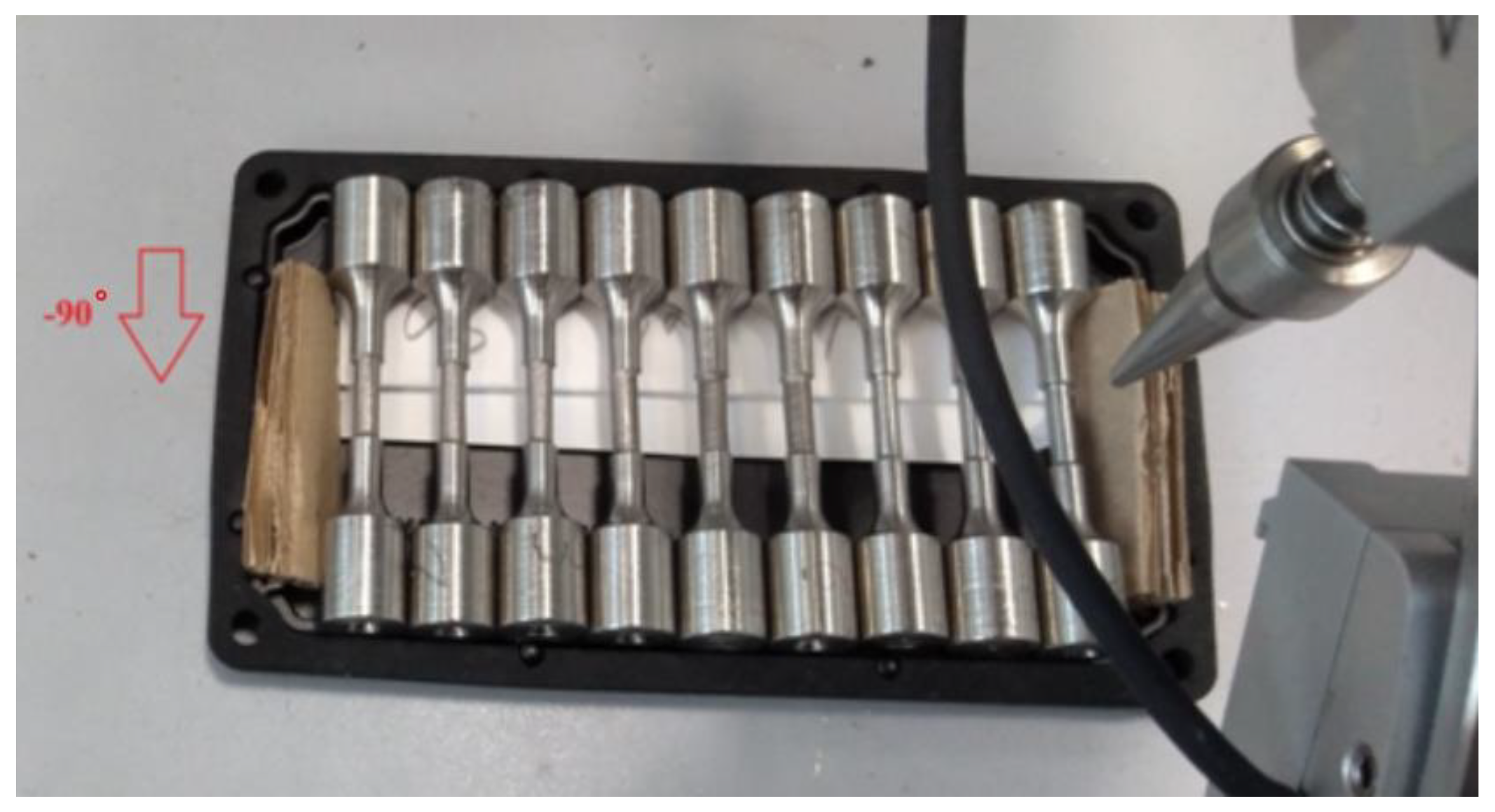
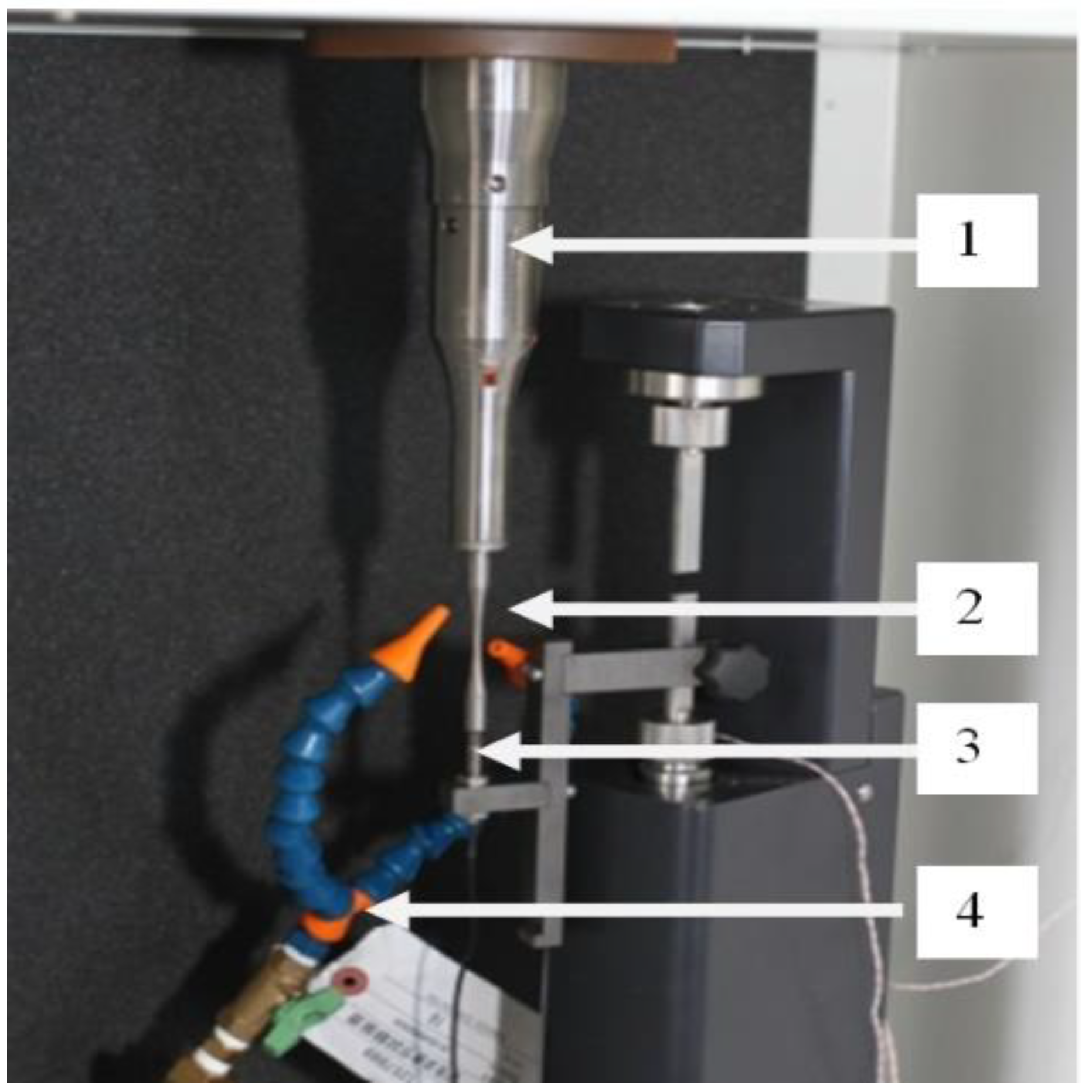
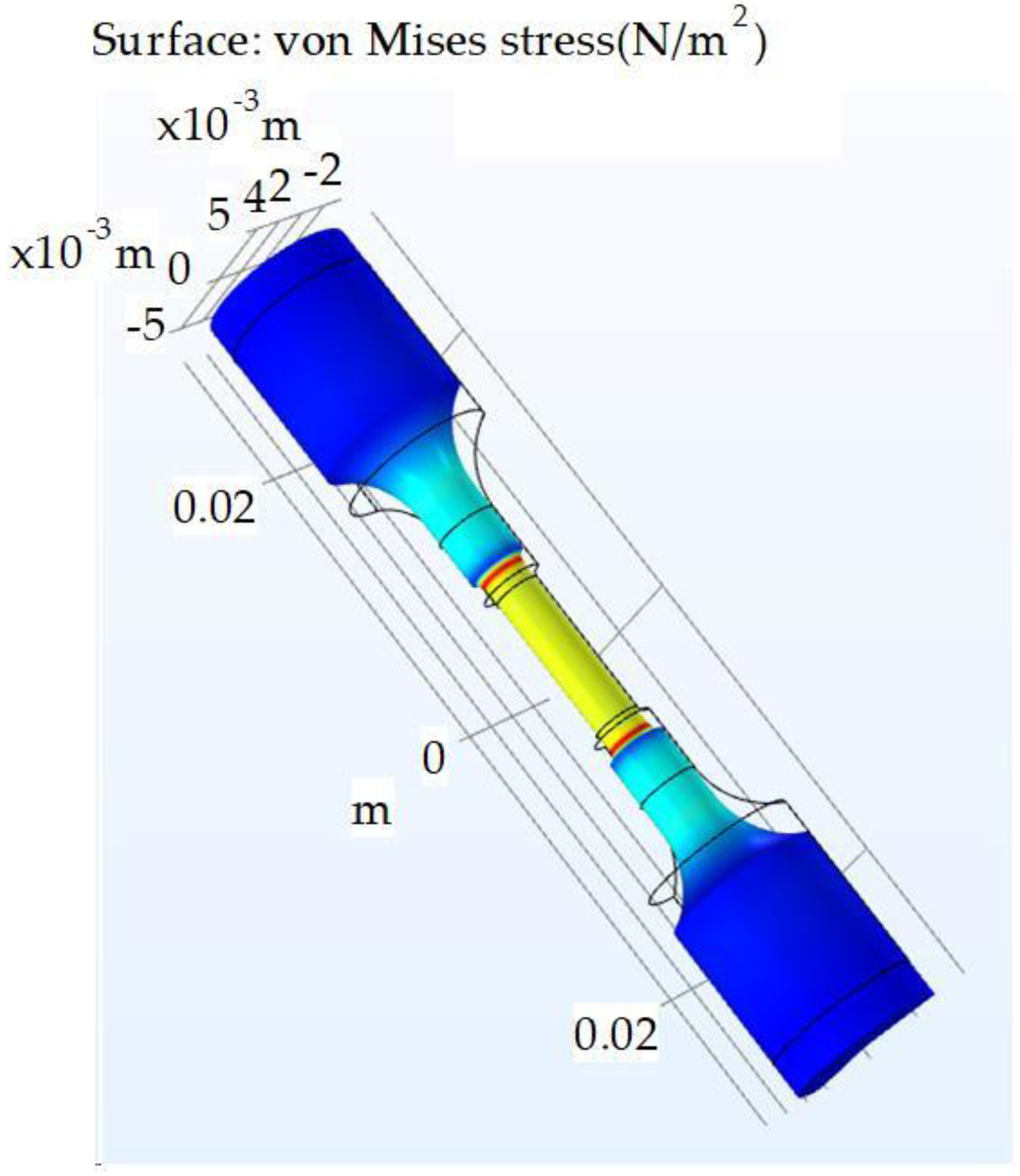
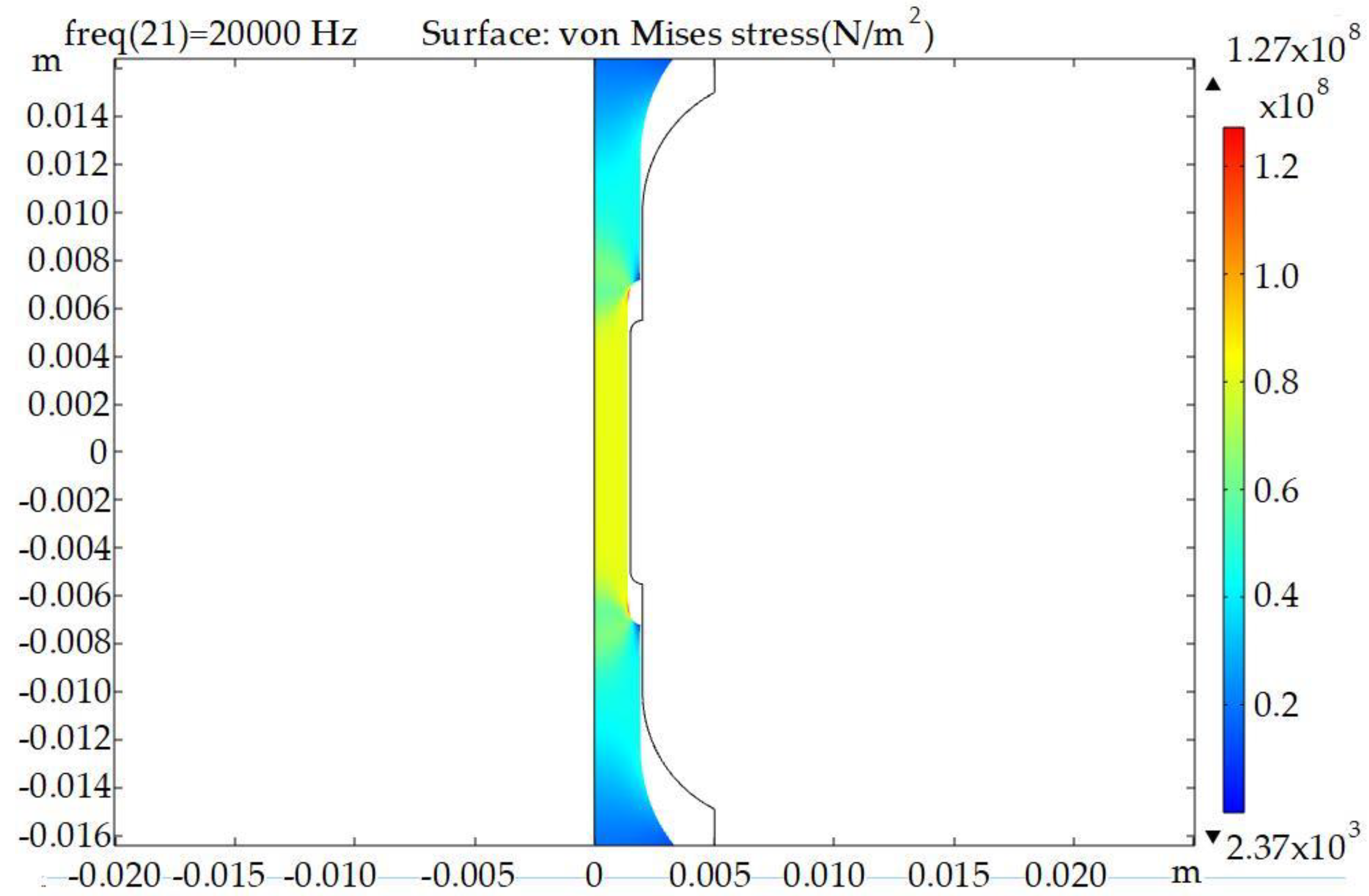
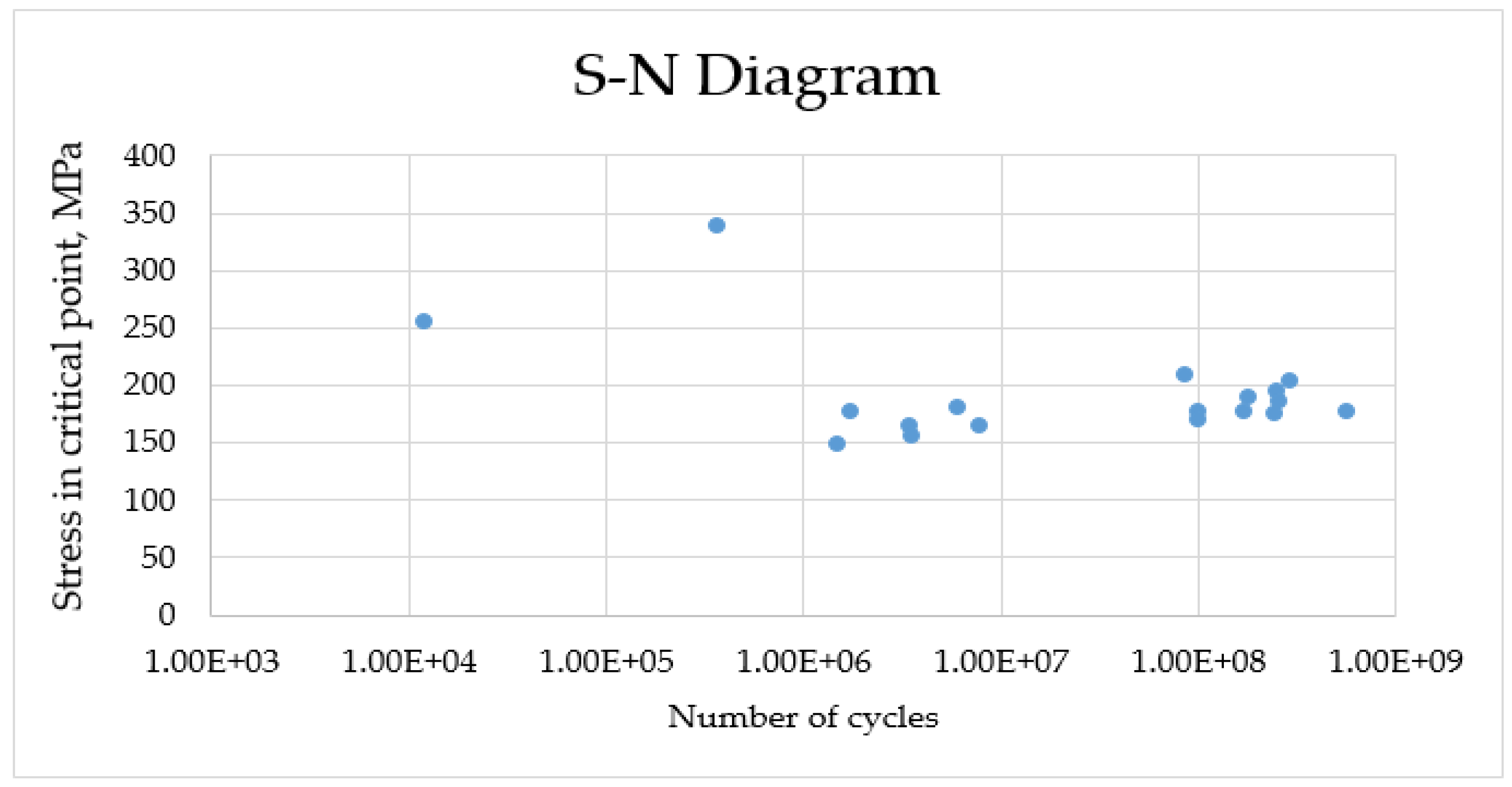
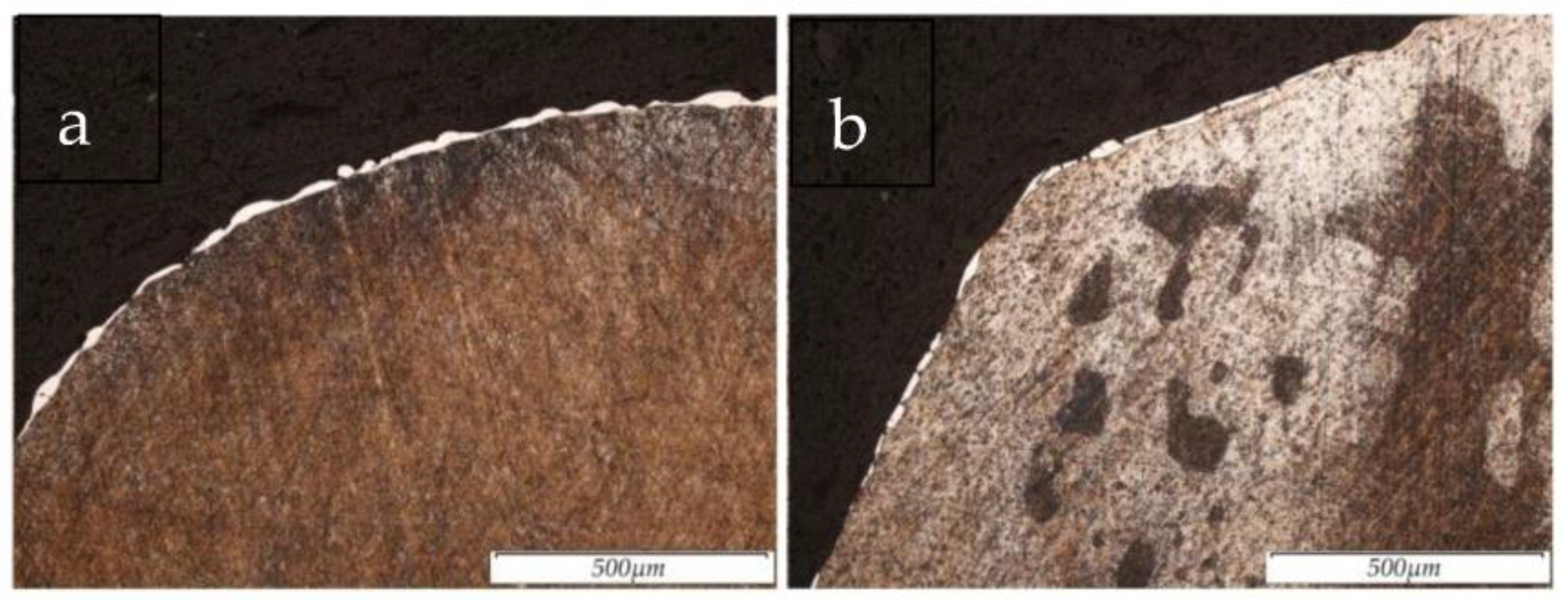
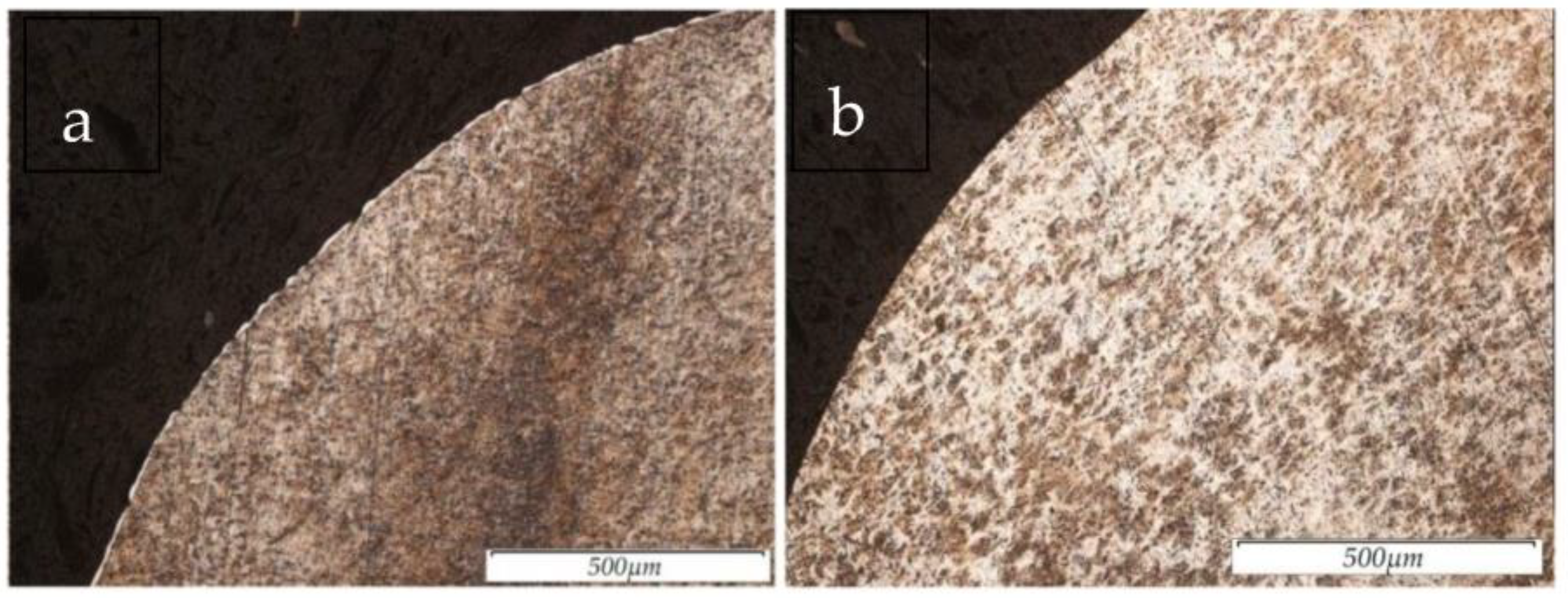
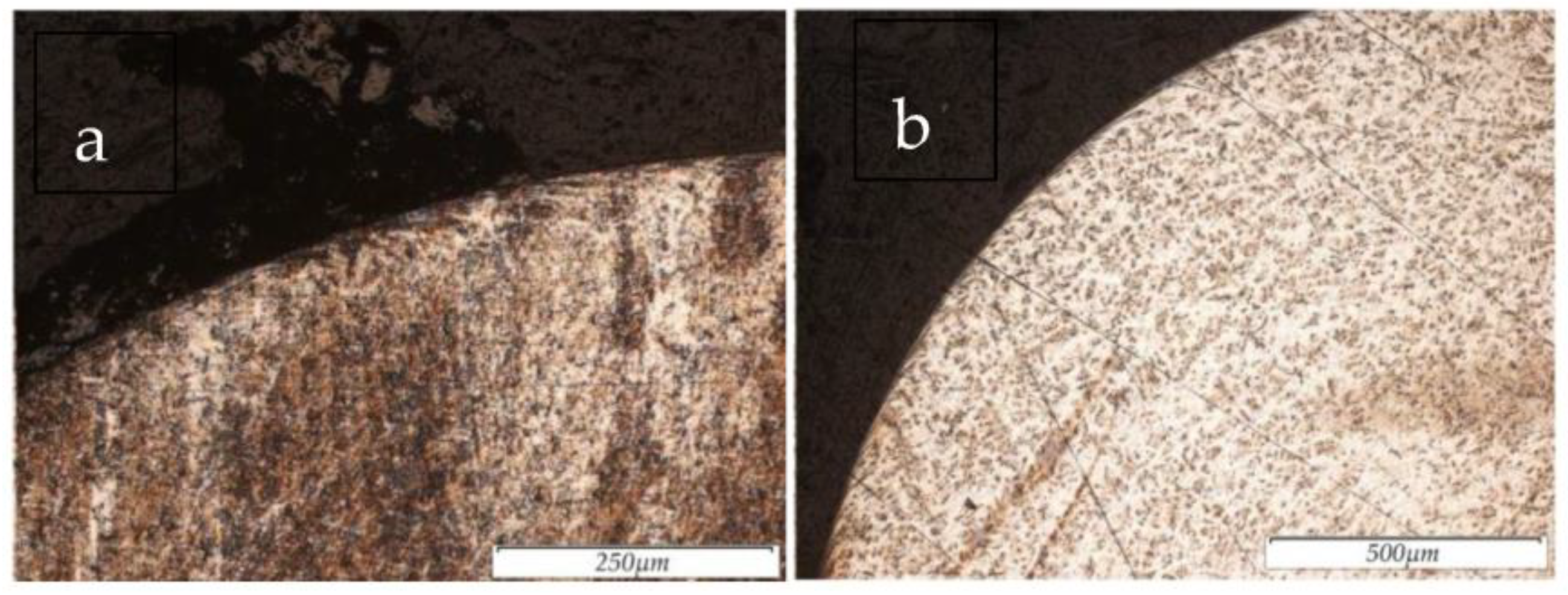
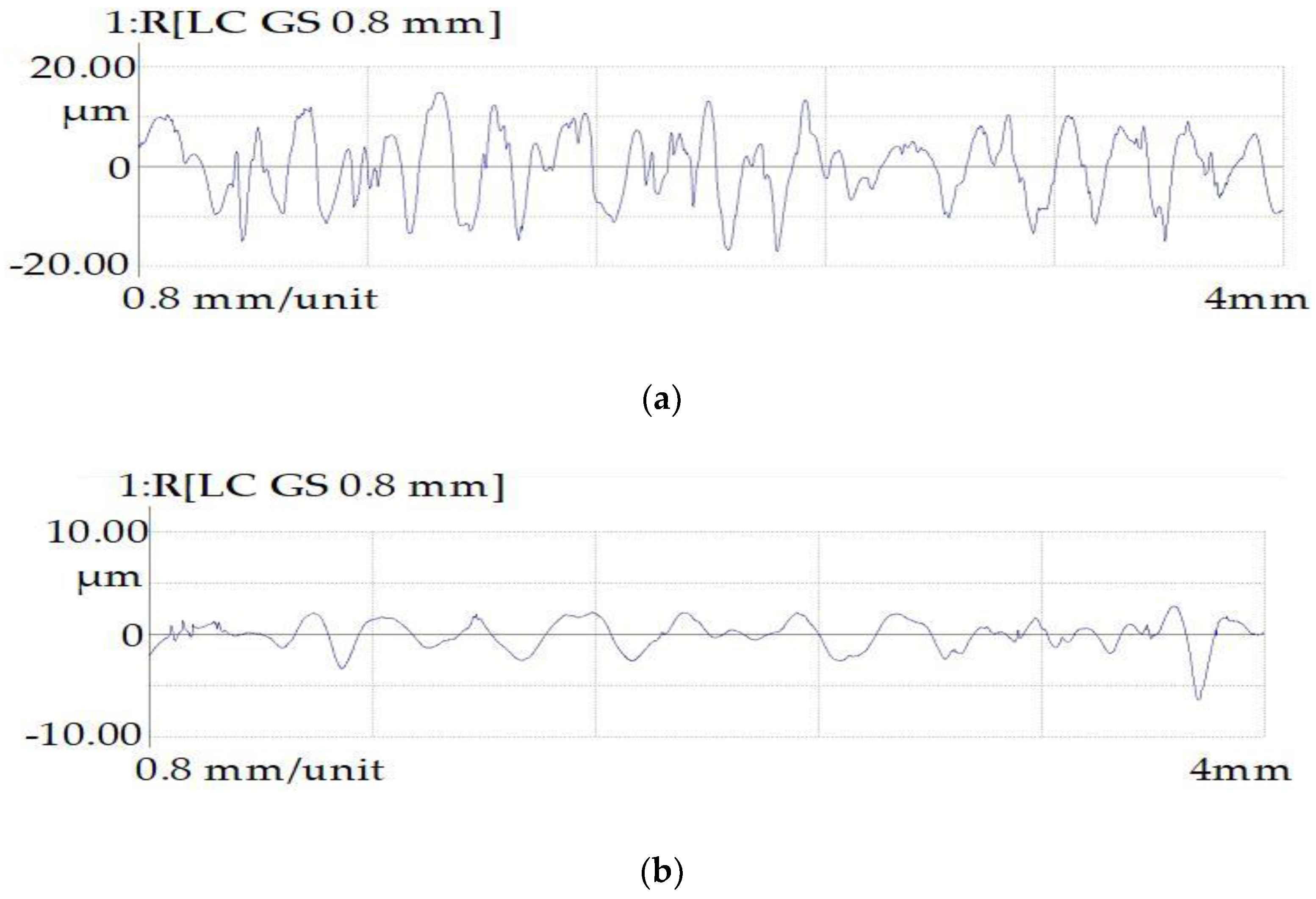
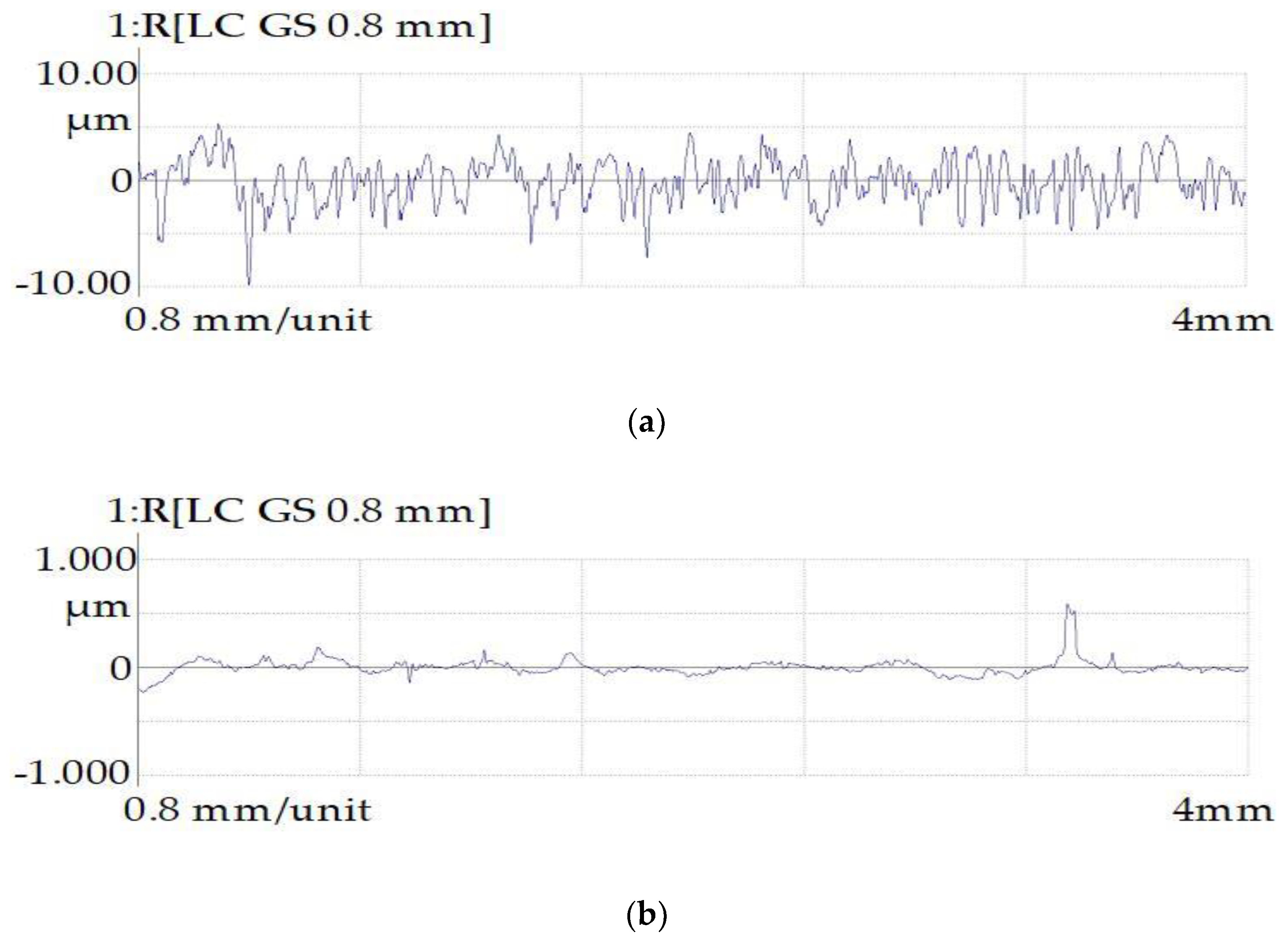
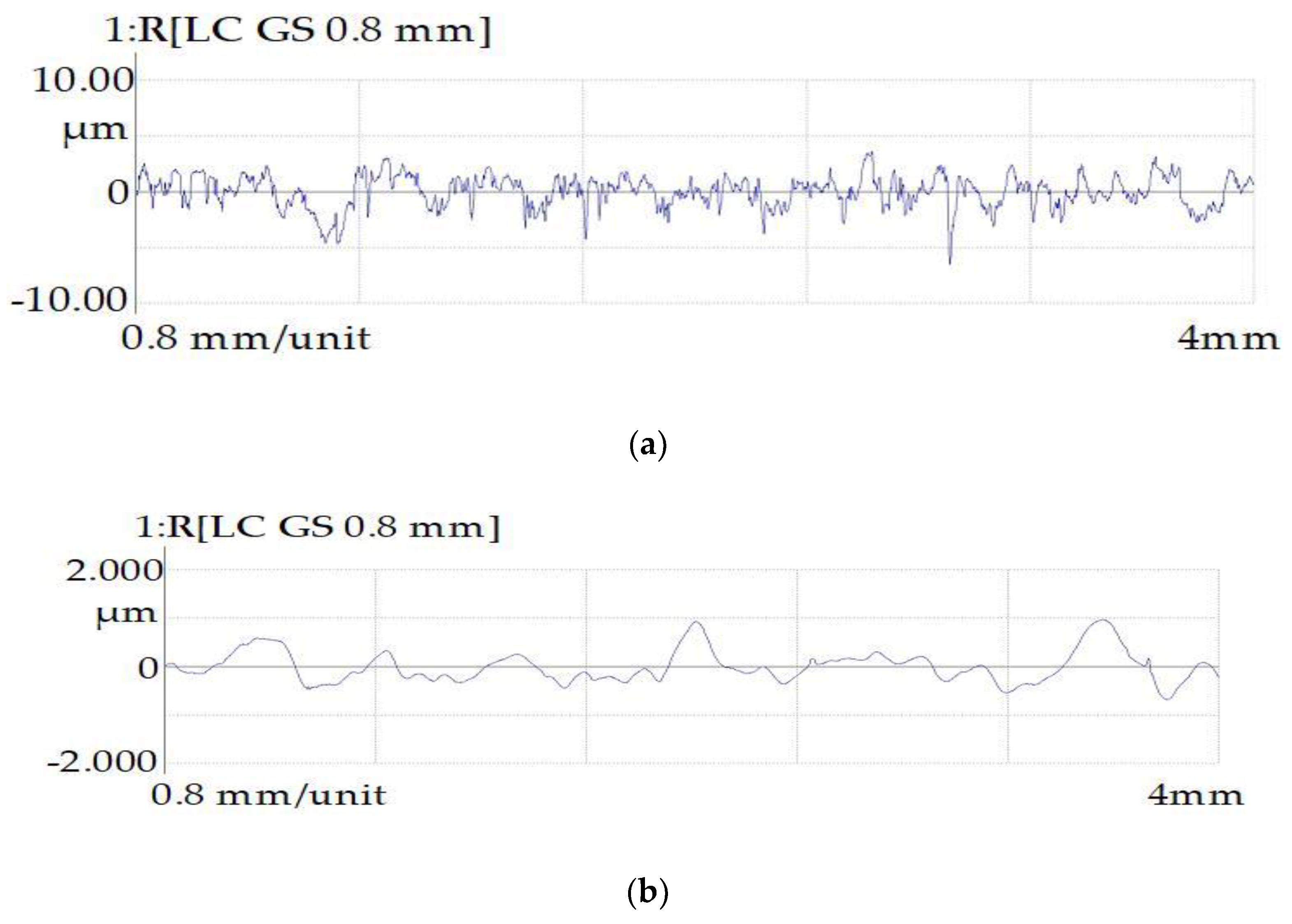

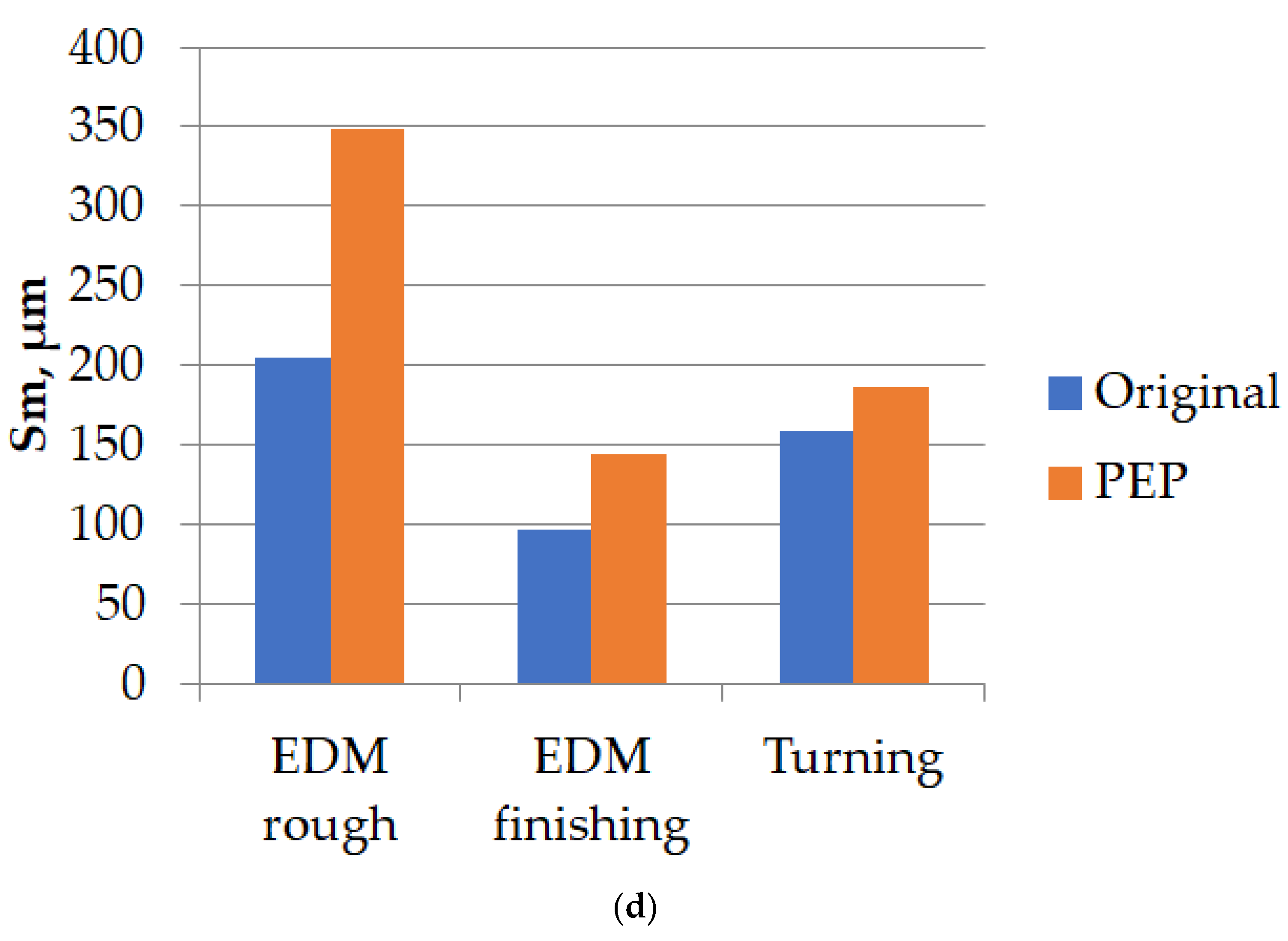
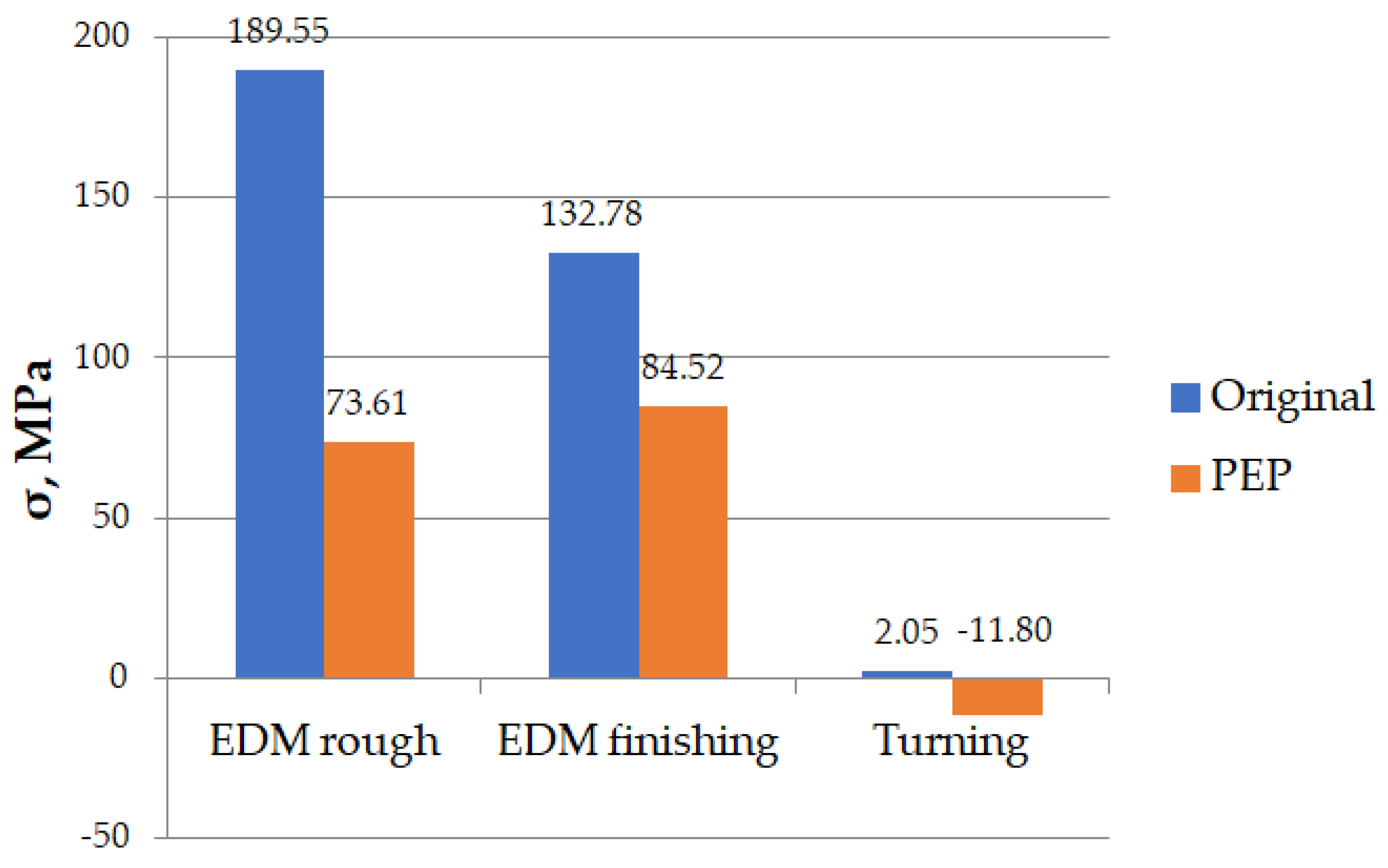
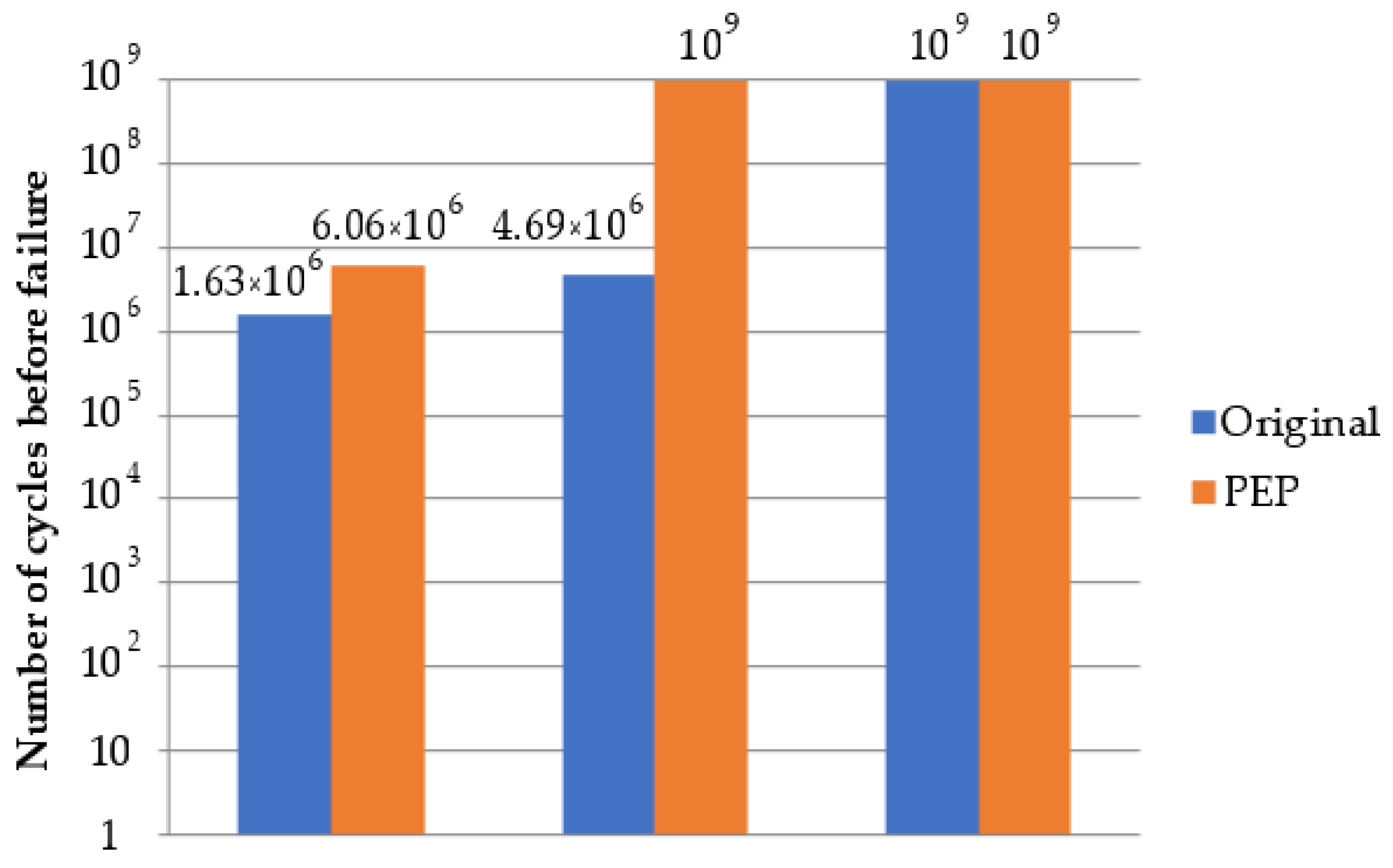
| Processing Mode | Current, I, A | Pulse Duration, Ton, µs | Voltage, U, V |
|---|---|---|---|
| Finish | 2 | 40 | 50 |
| Rough | 8 | 150 | 100 |
| Parameter | Value |
|---|---|
| Young’s modulus | 198,000 MPa |
| Poisson’s ratio | 0.30 |
| Parameter | Meaning |
|---|---|
| Method of measurement | modified “χ-method” |
| Collimator | 2 mm (Dia) |
| Directions ϕ to the analysis point | −90° |
| Anode Tube | Cr |
| Vanadium filters | Not |
| Diffraction line (hkl) | (220) |
| Diffraction angle 2θ | 148.9 deg |
| X-ray penetration depth at χ = 0° | 6.3 µm |
| Exposure time in one goniometer position | 65 s |
| Tilt angles χ | in the range [−30°;30°], are symmetrical in absolute values in both directions, where positive tilt angles are χ in the range [0°;30°] and negative tilt angles are χ in the range [−30°;0°] |
| Number of tilt angles ±χ | 13, where N + χ = N − χ = 7 (including χ = 0° and assuming that the measurement at position χ = 0° is carried out once) |
| Oscillations of the X-ray beam (oscillation) | 3 deg |
| Parameter | Meaning |
|---|---|
| Peak calculation | PeakFit Method |
| Peak level used for calculation | 75 |
| Subtraction of background radiation values | Linear |
| Setting 2θ angles | calibrated |
| Selecting anti-aliasing options | Not |
| Calculation of shear stresses | Elliptical Method |
| Calculation of principal stresses | Tridirectional method 0°, −45°, −90° |
| Stress tensor | Tridirectional method 0°, −45°, −90° |
| Displacement, µm | Stresses, MPa |
|---|---|
| 5 | 53 |
| 10 | 107 |
| 15 | 160 |
| 20 | 214 |
| 30 | 321 |
| Sample Processing Route | Thickness of the White Layer, µm |
|---|---|
| EDM (rough) + PeP | 16.48 |
| EDM (finishing) + PeP | - |
| EDM (rough) | 32.09 |
| EDM (finish) | 9.42 |
| Type of Processing | Content of Elements, % | |||||
|---|---|---|---|---|---|---|
| Fe | Cr | Ni | Mn | Si | Ti | |
| Initial (turning) | base | 17–19 | 9–11 | ≤2 | ≤0.8 | 0.4–1 |
| PeP | base | 17.2 | 9.9 | 1.3 | 0.6 | 0.6 |
| EDM (finish) | base | 18.1 | 9.9 | 1.1 | 0.7 | 0.4 |
| EDM(rough) | base | 17.6 | 10.1 | 1.2 | 0.7 | 0.6 |
| EDM (finish) + PeP | base | 18.8 | 9.5 | 1.2 | 0.7 | 0.5 |
| EDM (rough) + PeP | base | 18.4 | 9.6 | 1.0 | 0.8 | 0.5 |
| Type of Sample Processing | Roughness Parameters, µm | |||
|---|---|---|---|---|
| Ra | Rz | Rmax | Sm | |
| EDM (rough) | 5.50 | 26.08 | 31.94 | 204.85 |
| EDM (finish) | 1.56 | 10.10 | 13.14 | 96.21 |
| Turning | 1.27 | 7.68 | 9.93 | 157.93 |
| EDM (rough) + PeP | 1.05 | 5.52 | 8.41 | 347.95 |
| EDM (finish) + PeP | 0.25 | 1.21 | 1.72 | 144.03 |
| Turning + PeP | 0.53 | 2.32 | 3.45 | 185.86 |
| Type of Processing | No. Sample | Values of Residual Stresses, MPa | ||
|---|---|---|---|---|
| Point 1 | Point 2 | Average | ||
| EDM (rough) | 1 | 197.8 | 170.1 | 189.55 |
| 2 | 180.7 | 158.4 | ||
| 3 | 213.3 | 217 | ||
| EDM (finishing) | 4 | 137.8 | 131.3 | 132.78 |
| 5 | 139.9 | 135.6 | ||
| 6 | 124.4 | 127.7 | ||
| Turning | 7 | 14.3 | −15 | 2.05 |
| 8 | 24.1 | −25.6 | ||
| 9 | 35.5 | −21 | ||
| EDM (rough) + PeP | 10 | 67.7 | 80.4 | 73.61 |
| 11 | 70.35 | 75.4 | ||
| 12 | 68 | 79.8 | ||
| EDM (finishing) + PeP | 13 | 105.6 | 110.6 | 84.52 |
| 14 | 123.8 | 125.9 | ||
| 15 | 25.4 | 15.8 | ||
| Turning + PeP | 16 | −27.1 | −33.4 | −11.8 |
| 17 | −23.4 | 15.3 | ||
| 18 | 31.4 | −33.6 | ||
| Type of Processing | No. Sample | Fracture Location | Number of Cycles to Failure | |
|---|---|---|---|---|
| EDM (rough) | 1 | Fillet | 1.58 × 106 | 1.63 × 106 |
| 2 | Fillet | 1.80 × 106 | ||
| 3 | Fillet | 1.50 × 106 | ||
| EDM (finishing) | 4 | Fillet | 5.70 × 106 | 4.69 × 106 |
| 5 | Fillet | 3.57 × 106 | ||
| 6 | Fillet | 4.80 × 106 | ||
| Turning | 7 | Not destroyed | 109 | 109 |
| 8 | Not destroyed | 109 | ||
| 9 | Not destroyed | 109 | ||
| EDM (rough) + PeP | 10 | Fillet | 5.7 × 106 | 6.06 × 106 |
| 11 | Fillet | 6.35 × 106 | ||
| 12 | Fillet | 6.12 × 106 | ||
| EDM (finishing) + PeP | 13 | Not destroyed | 109 | 109 |
| 14 | Not destroyed | 109 | ||
| 15 | Not destroyed | 109 | ||
| Turning + PeP | 16 | Not destroyed | 109 | 109 |
| 17 | Not destroyed | 109 | ||
| 18 | Not destroyed | 109 | ||
Disclaimer/Publisher’s Note: The statements, opinions and data contained in all publications are solely those of the individual author(s) and contributor(s) and not of MDPI and/or the editor(s). MDPI and/or the editor(s) disclaim responsibility for any injury to people or property resulting from any ideas, methods, instructions or products referred to in the content. |
© 2023 by the authors. Licensee MDPI, Basel, Switzerland. This article is an open access article distributed under the terms and conditions of the Creative Commons Attribution (CC BY) license (https://creativecommons.org/licenses/by/4.0/).
Share and Cite
Ablyaz, T.R.; Shlykov, E.S.; Muratov, K.R.; Osinnikov, I.V.; Bannikov, M.V.; Sidhu, S.S. Investigation of Plasma-Electrolytic Processing on EDMed Austenitic Steels. Materials 2023, 16, 4127. https://doi.org/10.3390/ma16114127
Ablyaz TR, Shlykov ES, Muratov KR, Osinnikov IV, Bannikov MV, Sidhu SS. Investigation of Plasma-Electrolytic Processing on EDMed Austenitic Steels. Materials. 2023; 16(11):4127. https://doi.org/10.3390/ma16114127
Chicago/Turabian StyleAblyaz, Timur Rizovich, Evgeny Sergeevich Shlykov, Karim Ravilevich Muratov, Ilya Vladimirovich Osinnikov, Mikhail Vladimirovich Bannikov, and Sarabjeet Singh Sidhu. 2023. "Investigation of Plasma-Electrolytic Processing on EDMed Austenitic Steels" Materials 16, no. 11: 4127. https://doi.org/10.3390/ma16114127
APA StyleAblyaz, T. R., Shlykov, E. S., Muratov, K. R., Osinnikov, I. V., Bannikov, M. V., & Sidhu, S. S. (2023). Investigation of Plasma-Electrolytic Processing on EDMed Austenitic Steels. Materials, 16(11), 4127. https://doi.org/10.3390/ma16114127






